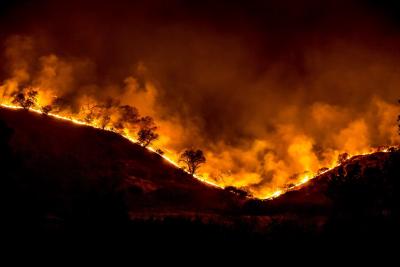Meteorological Conditions Influence the Size and Occurrence of California Wildfires
Recent increases in California wildfires have resulted in huge economic losses and threats to human health. Meteorology, the most important natural factor that influences wildfires, is well-resolved in both observations and models. Improving our understanding of and predictive capabilities for wildfires and their impacts requires clarifying the meteorological environments that favor wildfires. Scientists found that ~60% of California wildfires occur on hot-dry days, but hot-wet days account for ~12% of wildfires by favoring lightning flashes. They also found that the strengthening of high-pressure systems in the summer and fall combined with drying and warming to contribute to more large hot-dry wildfires from 1984-2017.
Understanding the physical factors that contribute to wildfires not only benefits wildfire forecasting and management, but also advances climate science and assessments of the socioeconomic impacts of wildfires. By systematically investigating 1535 California wildfires that occurred between 1984 and 2017, this study found that atmospheric moisture explains ~69% of the variability in wildfire sizes. With the doubling of the total burned area in California from 1984 to 2017, the insights from this study demonstrate the need to examine future changes in wildfires under warming conditions that could induce numerous changes in the meteorological environments.
This study systematically analyzed 1535 California wildfires from 1984-2017, using satellite fire data and meteorological reanalysis products to reveal the relationship between meteorological environments and wildfire occurrence and size. Most (~60%) wildfires occurred on hot-dry days. A large-scale meteorological pattern featuring persistent high pressure and a strong northeasterly wind descending from inland induces hot-dry conditions. Self-organizing map analysis lends confidence in the large-scale meteorological pattern dominating hot-dry wildfires in California. Other wildfires (12.2%) occurred on hot-wet days, which may be related to meteorological environments with high equivalent potential temperature supported by southerly onshore flow. These meteorological environments favor stronger convection, more precipitation, and more lightning flashes that provide a wildfire triggering mechanism. Meteorological anomalies also influence wildfire size, with a moisture anomaly accounting for the largest fraction (~69%) of wildfire size variability. The total area burned by wildfires has significantly increased, by ~3.6% per year, an overall doubling of burned area from 1984 to 2017, mainly dominated by hot-dry wildfires in the summer. The drying and warming of California and the strengthening of the high-pressure phenomenon may contribute to the changes in wildfires. Furthermore, increasing lightning flashes may have contributed to the increased frequency of hot-wet wildfires.

